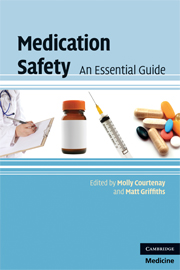Book contents
- Frontmatter
- Contents
- List of contributors
- Preface
- 1 Introduction to medication errors and medication safety
- 2 Safety in prescribing
- 3 Safety in dispensing
- 4 Safety in administering
- 5 Adverse drug reactions and drug interactions
- 6 Interface of care and communication
- 7 Parenteral drug administration
- 8 Calculations
- 9 Controlled drugs and patient safety
- 10 Reporting medication errors and near misses
- 11 Ensuring safety through evidence-based medicine
- Index
- References
2 - Safety in prescribing
Published online by Cambridge University Press: 22 January 2010
- Frontmatter
- Contents
- List of contributors
- Preface
- 1 Introduction to medication errors and medication safety
- 2 Safety in prescribing
- 3 Safety in dispensing
- 4 Safety in administering
- 5 Adverse drug reactions and drug interactions
- 6 Interface of care and communication
- 7 Parenteral drug administration
- 8 Calculations
- 9 Controlled drugs and patient safety
- 10 Reporting medication errors and near misses
- 11 Ensuring safety through evidence-based medicine
- Index
- References
Summary
Introduction
This chapter sets out the rationale for improving prescribing safety, namely the high rate of deaths, unnecessary hospital admissions and illness caused by unsafe prescribing; and what practical steps prescribers should take to reduce the risk of issuing an unsafe prescription. The tragedy in Northwick Park in 2006 when healthy volunteers suffered catastrophic consequences, albeit in the first test of a new drug, highlighted how pharmaceuticals need to be treated with caution and respect (Sunthralingham, 2006). However, it is not just new drugs which can be unsafe; drugs which have become established after many years of clinical use can also cause problems (Lasser et al., 2002). For example, after several years of use, a widely used non-steroidal anti-inflammatory drug was found to be associated with an increased risk of myocardial infarction (Solomon et al., 2004).
The first part of this chapter describes why prescribing safety is so important and this is addressed under the following four themes:
(1) Key issues for safe prescribing at the point of care. Theme one explores the safety issues that should be considered by an individual prescriber before issuing a prescription. A key message for prescribers is that they need to have the necessary information to hand at the point of prescribing: an understanding of the patient's wishes; access to a comprehensive medical record; and access to information about the drug they are about to prescribe.
[…]
- Type
- Chapter
- Information
- Medication SafetyAn Essential Guide, pp. 7 - 24Publisher: Cambridge University PressPrint publication year: 2009



